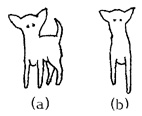


A Closer Look at the
Chihuahua
by Laurence Fitt-Savage
Movement

If the hindquarters are better angulated than the front and provide more drive than the front can accommodate, problems occur. Unless a corrective remedy is found the dog 'pounds' - the front legs hit the ground before the hindlegs have completed their forward push, the resultant excessive strain may cause the dog to 'break down' in front, especially at the pasterns. Excessive rising and falling at the withers often betray this condition. To avoid pounding, the dog may flick up its front pads just prior to impact. This reduces the shock of impact, the dog lands on the heel pads, which act as buffers. 'Padding' as this fault is known, often looks most smart to the casual observer, but it is only the dog's natural compensation for its structural deficiencies, and a trap for the unwary!
An alternative method of avoiding contact is to throw the front legs high in the air, the 'Hackney' gait. This is specifically described in the standard as a fault, in part because, for just a few specific toy breeds this is, for differing reasons, the required gait.
[ Next ]
Skull ::
Jaws and Cheeks ::
Muzzle ::
Bite ::
Eyes ::
Ears ::
Neck ::
Forequarters
Shoulder ::
Movement ::
Balance ::
Forehand ::
Foreaction ::
Musculature
Hindquarters ::
Hindaction ::
Croup ::
Angulation ::
Back ::
Body Shape ::
Chest ::
Tail
Reproduced from the British Chihuahua Club Handbook 1987